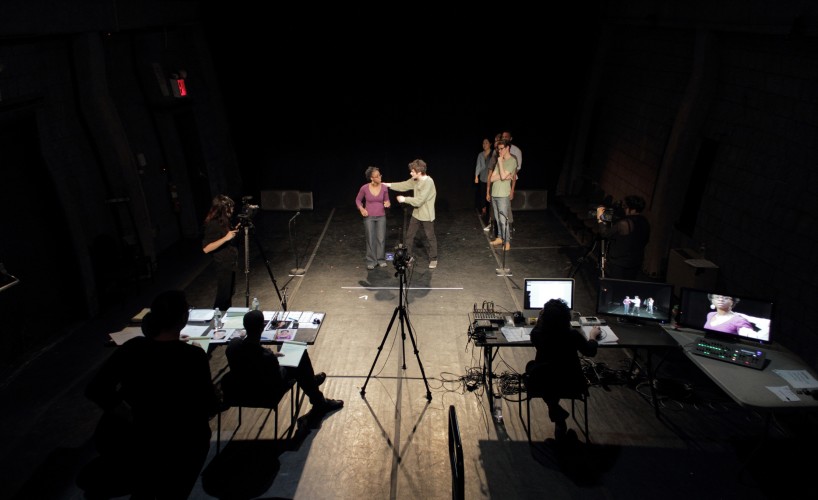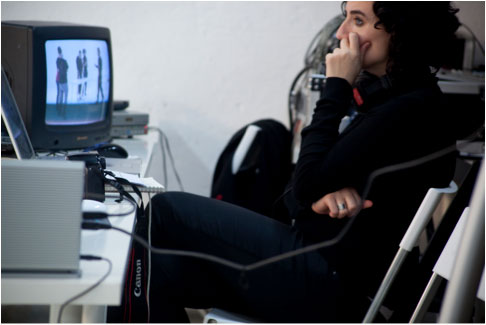“I think a lot,” laughed the artist Itziar Barrio, stationed at the desk in her fifth floor studio at CSV (Clemente Soto Velez) on Suffolk Street in Manhattan. “That’s my job!”
We were discussing her past eight years working as a full time artist – six of them in New York City, though she works internationally and can be found showing video, illustration and painting in New York, her native Spain, and recently in Budapest, Havana and Montreal.
Itziar will be showing four of her short films on May 25, 2013 at our arts showcase at the Acheron in Bushwick. Her unique short films, all under 15 minutes will screen between live performances by Claire’s Diary, The Tablets, Tiny Tusks and Bad Behavior – more here.
Featured on these pages for her previous projects in Brooklyn, Itziar is a cultural force unto herself. She will screen “We Could Have Had It All” – a multi-layered digital video inspired by the Adele lyric and concert at Albert Royal Hall, which is a response to the popular lyric by a duet of poems. Basque poet Maialen Lujanbio and American writer Chavisa Woods contribute original poems in their native tongues about the concept of “having it all” inside the historic Teatro Arriaga, a theater in Itziar’s native Bilbao.
Itziar’s digital video titled RETURN interviews Crown Heights residents on the changing dynamics of the neighborhood and what they consider to be “paradise” in a neighborhood full of people originally from the tropics. We’ll screen this film and two others from Itziar’s BLUE WALL PROJECT: THE MUSIC STARTS BEFORE THE DANCE BEGINS and WE, both of which examine the ever-changing face of blocks in Williamsburg, the Lower East Side, and the historic memory that we carry within us.
What originally brought Itziar onto my radar was a giant billboard with tropical graphics that coincided with RETURN, which she designed and put up in 2009 on the corner of Fulton Street and Nostrand Avenue in Crown Heights. It read, “Welcome to the New Paradise/ You, a Lonely Wildcat.”
In our 2009 interview Itziar hinted at her next project: “The only thing I could say is that I may be working with a theater director and performers in order to create a video about group dynamic and behavior.”
I had been invited to stop by Itziar’s studio after I attended a press preview for that very project, which now has a name, Casting THE PERILS OF OBEDIENCE, and was getting ready for a weekend of performances at the Abrons Art Center on the Lower East Side. It was the second iteration of a project started in Spain the year after we first spoke. The performance consists of a live auditioning process, navigated by a director, filmed by a crew and all of it led by Itziar, whose face remained hidden behind giant Mac screens, back turned to audience.
The project is both performance art and a film in progress – collaboration with the theater director Niegel Smith, known for his work as associate director of FELA! According to Itziar, it’s named for “the title of a [Stanley] Milgram experiment about proving how much pain can somebody inflict on some other person on their authority, so it’s questioning a lot about how we all deal with power, it’s a really current concept in my practice in general.”
It was the last week of March when I had stopped into the Abrons Arts Center, just south of the Williamsburg Bridge’s Manhattan side, where actors had been called to audition for roles that were not quite explained to them, and after an exhausting display of their improvisational skills, were also subsequently interviewed in depth about their personal lives to understand, unbeknownst to them, if they fell into one of four personality types: leader, navigator, soldier and anti-leader.
I asked Itziar which roles she was adapting to in the project.

“I guess I am the leader, the leader of the project!” she offered with another big laugh before pausing. “But I play different roles, because this is a project – especially on the theatrical aspects – I’ve been developing it with Niegel, the director. I’ve been working with him on the state of the project when we select the people and that is a negotiation – sometimes he’s the leader, you have seen me probably assuming his roles. So that is a negotiation all the time, I guess at the end of the day, the entire project, it’s me, for the good and for the bad.”
I asked Niegel – a founding member of the directors’ lab 425D – the same thing. “Sometimes I’m the anti-leader,” he told me, laughing at the prospect, “because I bring a whole set of assumptions based on the theater that she doesn’t and sometimes I have had to push those and you know, ultimately she makes the final call.
“I find myself,” he continued, adjusting, “there are certain ways in which I pushed, there are certain ways in which I have given up control. I was telling Itziar when I first got here – I’m used to walking into the theater and having absolute control, you know?
“So this is very new for me so I’m trying to allow myself space for that, and there are of course a set of choices in this process that aren’t my choices that I have had to make peace with,” he told me.
And such is life – the power dynamics of which fascinate Itziar. In Casting THE PERILS OF OBEDIENCE, each actor called back from the open casting call will find that their role in real life and on stage are mirrored – a byproduct of Itziar’s obsession with the line between fiction and non-fiction. Specifically her work lingers most often on how we each create reality through language and Itziar is great at reflecting it back at us.
“In the fiction and non-fiction, the person and the character, you will see there are things that are related to their personality – I’m super interested in the fiction and non-fiction, so in the video that will come I will definitely deal with both aspects,” she said.
Niegel and casting director Arnold J. Mungioli, of Mungioli Theatricals, chose actors based on personal interviews and improv audition performances with a group, all while Itziar and her crew filmed the process. Then, in callbacks in front of a live audience, the actors set out to perform “sides” or short scenes from three iconic moments in film: the negotiation in Basic Instinct, the tipping scene in Reservoir Dogs, and Bette Davis’ speech in All About Eve.
Somewhere in between the real person and their assumed character emerged the individual roles of the actors, and the audience would participate by reinforcing those roles with their authority. By examining our roles through the lens of these iconic moments, Itziar reveals how much we base our perceptions in fiction.
“I really like using big icons that we all understand and put them in a new realm, to try to talk about, what does it really mean?” Itziar told me while we were at Abrons. It was just like her response to Adele’s concept of having it all, I thought.
“I’m saying, there’s always a story,” she told me, as we shifted to her interest in history affecting this process, “I’m going to write it; I’m going to let it happen; I’m going to the beginning of the beginning; I’m going to the beginning of the casting.”
She seemed to always want to know how everything gets started. And part of this story started half a century ago. In a 1974 article, “The Perils of Obedience”, Milgram, a PhD, summarized his experiment, having taken place in 1961, writing:
The legal and philosophic aspects of obedience are of enormous importance, but they say very little about how most people behave in concrete situations. I set up a simple experiment at Yale University to test how much pain an ordinary citizen would inflict on another person simply because he was ordered to by an experimental scientist. Stark authority was pitted against the subjects’ [participants’] strongest moral imperatives against hurting others, and, with the subjects’ [participants’] ears ringing with the screams of the victims, authority won more often than not. The extreme willingness of adults to go to almost any lengths on the command of an authority constitutes the chief finding of the study and the fact most urgently demanding explanation.
Ordinary people, simply doing their jobs, and without any particular hostility on their part, can become agents in a terrible destructive process. Moreover, even when the destructive effects of their work become patently clear, and they are asked to carry out actions incompatible with fundamental standards of morality, relatively few people have the resources needed to resist authority.
On average the experiment yields a majority of around 60% of participants that inflict what they believe is a fatal blow to another human – read the study, it’s fascinating. It was the personality traits and roles within this dynamic that fascinated Itziar enough to engage this work and examine, between the lines of fiction and non-fiction, our individual sense of authority that keeps people moving in certain directions.

That authority is strong in the art world – a hierarchy, Itziar says, that is not breaking down anytime soon. “There are still roles and they’re still very rigid.”
Casting THE PERILS OF OBEDIENCE is a commissioned piece that will eventually become a film and an installation, but for other works Itziar writes exhaustive grants, which she’s grown accustomed to as part of the gig. “I think of art as a job, so what’s going to get you paid?”
“I don’t need to be super known, or this big star or celebrity kind of flavor, thing, you know what I mean? I don’t even know why we need that, to be honest, if it would be a regular profession we would not need that, right? The spectacularity of it. You just work and do things. It requires different things. What is so different from any other profession?”
Well, just ask about what she’s working on next: “I’m going to be analyzing the fist, from the different points of view from the political, the sexual and the social perspectives.”
Oh, that’s what.

[…] The argument relies too heavily on the notion that one makes art to be a star – we’ve profiled at least one who would contest that – and that when faced with hardship or struggle, one […]